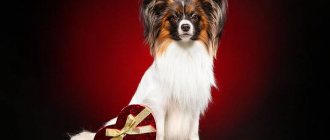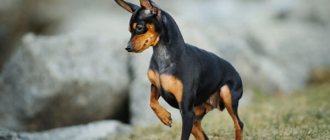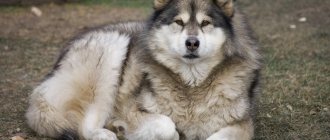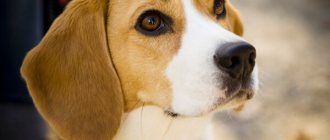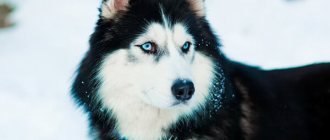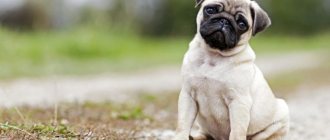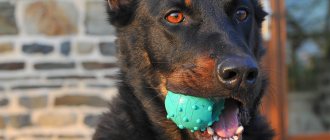- Description of the breed
- Nurseries
- Photo
- Lifespan: 9-11 years
- Weight: males 59-77 kg, females 45-59 kg
- Height (height at withers): males 74-80 cm, females 61-74 cm
- Puppy price: Starts from 30 thousand in domestic nurseries, and up to 100 thousand.
Leonbergers are huge, furry dogs with a balanced temperament. Can be used as guard dogs, companions, family dogs.
Origin story of the Leonberger
The breed was named after a small town in Germany - Leonberg, whose name when translated sounds like “lion city”. In the 30s of the 19th century, Heinrich Essig, a well-known dog handler engaged in breeding work throughout the country, lived here. And one day he had a significant idea - to breed a new type of dog, symbolizing his city. Naturally, the symbol of the “lion city” could only be a lion or a dog very similar to it. This was the main condition for the breeding activity of a felinologist.
There is an official version on this matter, according to which the birth of the breed began with the crossing of two giant dogs, it was a black and white Landseer and a long-haired St. Bernard. The result obtained was used for further work and was crossed with representatives of a variety of breeds. At the last stages, the dogs were mixed with two large breeds - St. Bernards and mountain dogs from the Pyrenees. As a result, the light saw a huge dog with silver-gray fur and a black mask on its face.
Somewhat later, Leonbergers with a yellow-brown color began to appear, which brought them much closer to the appearance of a mountain lion. The breed was officially recognized only in the mid-20th century.
The author of the official version of the appearance of this breed was Essig. But after his death, some experts, including dog handler Strebel, expressed doubt that it was St. Bernards who participated in the breeding activities. All indirect data pointed more towards another theory - the ancestors of Leonbergers were mountain “Alpine” dogs. And today this version prevails among dog handlers.
There is also some documentary evidence that such dogs existed earlier, in the 17th and 18th centuries. Then it turns out that Essig was not engaged in breeding a new breed, but in reviving a previously existing one.
- Cute dog breeds
- The richest animals
- Cat claw attachments
- Dog
- Long-eared cats
- Cat meowing
These dogs were considered truly royal, as they lived at the court of many royalty - Frederick of Baden, Prince of Wales, Napoleon III, Nicholas II, etc. But, despite this, Leonbergers more than once found themselves on the verge of extinction. At the beginning of the 19th century there was an epidemic of distemper among representatives of this breed. And the world wars reduced the entire population of dogs to nothing, then only three purebred individuals managed to survive. But this turned out to be quite enough, albeit for painstaking but successful restoration work.
Historical reference
The Leonberger dog breed is one of the types whose appearance and character are the result of long-term work by breeders, and not natural selection. In addition, this is a breed of local origin: it is based on aboriginal dogs from one province of Germany.
In the late thirties and early forties of the 19th century, Heinrich Essig, a member of the city council of Leonberg, near Stuttgart, crossed a black and white Newfoundland with a male named Barry (St. Bernard) from the monastery shelter of St. Bernard.
Later a cross was made with the Pyrenees Mountain Dog. As a result, very large dogs with a dominant long coat of white color were born.
Essig sought to create a dog like a lion. It is the lion that proudly flaunts on the coat of arms of the city of Leonberg.
The first true Leonbergers appeared in 1846. They combined the excellent qualities of the original breeds, and soon these dogs, sold in large numbers throughout the world, were perceived as a symbol of the city of Leonberg.
At the end of the 19th century, Leonbergers were kept primarily as farm dogs in Baden-Württemberg. They were highly valued for their guarding and drafting abilities. During two world wars and the difficult post-war periods, the number of breeding dogs decreased dramatically.
The Leonberger of today is a wonderful family dog that meets all the requirements of modern life.
Description of the Leonberger breed
A Leonberger dog gives a feeling of power at first sight. This large, proportionally built dog is indeed very strong and was once even used to transport heavy loads. But for all its bulkiness, it is very dexterous, agile and flexible.
To get to know the breed better, let's look at the breed description together:
- The height of an adult Leonberger male at the withers is 72-80 cm, females – 65-75 cm;
- the Leonberger's weight ranges from 41 to 75 kg, with males being much larger than females;
- the head is large with medium-sized ears that hang down to the cheeks;
- eyes dark to light brown, although dark is preferred;
- the eyelids fit tightly to the eyeball; the expression of the eyes is thoughtful and reasonable;
- a dog is supposed to have 42 teeth, but with the possible exception of the absence of molars (M3); The dog has a scissor bite;
- body with a flat back and sloping loin, but in no case humpbacked or arched;
- the paws are smooth and powerful, stronger in a male than in a female;
- the dog’s movements when running are powerful and sweeping;
- the tail is lowered and curled, and when moving it should not rise above the back;
- the coat has a thick undercoat, very soft, without parting, can be smooth or slightly wavy; there are “pants” on the hind legs, and a mane on the chest and neck, which makes the dog look like a lion.
Distinctive features
The Leonberger is a large, stocky dog with a thick, rather long coat of brownish-yellow color. A distinctive feature is a voluminous mane on the head and a black mask on the muzzle. Its appearance alone can inspire fear, but in reality this dog is good-natured and playful.
Initially, the breed was bred to be large, so its representatives are impressive in size. Height can range from 65 to 80 cm, and the acceptable weight of giants is from 72 kg. The modern standard was edited in 2002, according to which all individuals that do not meet external characteristics are discarded.
- The head is proportional to the body, quite large, but not heavy. The length of the skull and muzzle are approximately equal, but the width of the skull is less than its depth. The stop is outlined, but represented by a smooth line.
- The muzzle is wide and level (not narrowed), slightly convex on the sides, and quite long. The cheekbones stand out. The jaws are strong and strong with 42 teeth, a scissor bite The lips are thin, do not sag, and fit tightly. Pigment – black.
- The nose is wide, black with open nostrils.
- Not too wide at stop level, eyes . They have an oval shape, are not large in size, and are not planted deeply. The color of the iris is dark brown.
- The ears are set high, but not long, hanging down on the sides of the head, represented by a rounded triangle. Wide at the base and quite fleshy.
- The body is quite long, although the dog is rather square in shape. The length of the body in relation to the height at the withers is 10/9. Well built, muscular and strong boned. The back is flat and wide, the loin is elastic, the croup is long and sloping. The withers are clearly visible, especially in males. The chest is deep (half the height at the withers) and wide, the ribs are rounded. The neck is long without dewlap. The stomach is tucked, but not much.
- The tail is set
below the line of the croup, hangs down when calm, is fairly long and covered with thick hair. When active, carried below the line of the back, slightly curled. - It has strong, straight, parallel, long limbs . Erect joints . The paws are straight, not turned to the right or left, the toes are firmly assembled, the pads are hard black, the claws are strong. Movements are wide, graceful, without clumsiness.
- The coat can be soft or coarse, does not fall into partings, stands rigidly, emphasizing the contours of the dog. Waviness is allowed. Extensions on the tail, chest and head.
- Color ranges from red to sandy yellow with black or brown streaks. There should always be a black mask on the face.
Leonberger breed colors
Leonberger has a wide range of red colors - from light sand to dark red - there are a lot of variations. The main thing that the breed standard says is that the dog’s coloring should not contain gray or brown. Also, the breed is not characterized by zonal coloring. The Leonberger also has a so-called “mask”, which covers the head and partially extends to the shoulders. This is a darkening of red fur with black color.
The Leonberger may have white fur on its chest, but not more than a palm in width. The dog may also have individual white hairs on its fingers. In order for your pet's fur to always look great, it needs regular care in the form of combing.
If a dog's mask is incomplete or missing altogether, this is a disqualifying fault for the breed.
Pros and cons of the breed
pros
- Could be a watchman.
- They obey the owner. They fulfill his requests.
- They love children.
- They are in good health.
- Non-aggressive.
Minuses
- They cannot live in apartments. They need room to move.
- The coat requires constant brushing.
Leonbergers are very cute dogs that resemble a lion. They need to be trained from early childhood.
Only through proper training and socialization will they become reliable guards.
Leonberger character
By nature, the Leonberger is cheerful, affectionate and friendly, the embodiment of everything that people love in dogs. They are loving, gentle and caring. This is the best family dog and companion, obedient, fearless, devoid of aggression and timidity. Copes well with the role of a guide dog, is smart, sociable, obedient, and can safely accompany you everywhere. You won't find a better babysitter for your baby. When you hear a child crying, you will immediately go to calm him down, even if it is not your baby who is crying. Remember, love for children is characteristic only of adults. A puppy in a game can easily knock over or bite a baby, mistaking him for a fellow tribesman.
Moderately large in size, it is better not to leave a small child alone with the dog. Amenable to training and education. Training should begin at three months of age. Don't yell or punish your puppy without reason.
Be patient when learning, or seek help from a specialist. Reacts very painfully to screams or family quarrels. When raising a Leonberger puppy, follow the same rules as when raising puppies of other large breeds. Be sure to monitor the formation of the bones and paws. Choose the right diet and no excessive exercise. Until the age of 1 year, you should not take your puppy up the stairs, do not let him jump from a height, and do not force him to run a lot.
Leonberger is self-confident, has a medium temperament, and equanimity. He is infinitely devoted to his owner and all family members.
Unlike other guard breeds: Moscow watchdog, black terrier, Doberman, etc., it is not characterized by aggression, anger, or the desire to dominate. Although this does not spoil his watchdog qualities, he will guard his territory properly and will not let a stranger through.
Breeders love him for his lively and cheerful disposition, which distinguishes the Leonberger from other guard breeds. It remembers commands very well and, if trained correctly, will understand its owner perfectly. You should punish your pet very carefully, never hit the dog, he himself knows perfectly well when he has done something wrong, and will immediately apologize, you just need to scold him a little.
Features of character and behavior
Leonbergers are described as even-tempered dogs with a kind, easy-going disposition . Despite its size, the dog is not prone to dominance or stubbornness, and is easy to raise and train. Problems can indeed arise, but only because of the size of the pet. It has good protective qualities, but is devoid of aggression and hatred towards people.
The breed is not widespread in Russia, and in principle is considered one of the rarest . Therefore, it is difficult to find reviews about these dogs. But everyone who has ever owned a Leonberger is sure that this aristocratic-phlegmatic dog is an ideal option for a family.
Advantages
- The breed was actually bred as a working and guard dog. These dogs have good physical characteristics and instincts that allow them to detect and prevent danger. For some time they were even used as mounts, which defines pets as strong and hardy animals.
- Leonbergers are phlegmatic by temperament, but love to play with their owner and children, who are treated better than just well. They like to monitor and help children of different ages; such dogs are often appointed as nannies. Aggression is not considered a standard quality of the breed, so angry individuals are excluded from further mating.
- These dogs are balanced, can adapt to any person and get along with any owner. It is important for them to be near their family and protect them from external dangers. With proper socialization, the Leonberger will not react to other pets and will be reserved towards strangers.
In addition, the breed is truly unusual and original. It is a great honor to have such a pet.
Flaws
- Despite all the positive qualities, the breed is indeed very large . Caring for it will not only be difficult, but also costly. In addition, it is important to instill all manners of behavior in society in order to avoid accidents, because such a dog can even unintentionally harm a person.
- It is not recommended to leave Leonberger puppies and children alone. While the dog is not yet trained, it can injure the child during play.
- Without proper training, individuals can become either withdrawn and timid, or overly aggressive and angry.
Health
Characteristic diseases
Experts include hip dysplasia, allergies and dermatitis, Addison's disease, osteochondrosis and hypothyroidism on the list of the most common diseases in the breed. Cataracts are rare in this breed. Addison's disease is characterized by dysfunction of the adrenal cortex. A dangerous and difficult to diagnose disease. If the disease is severe, the pet experiences weakness, its heart rate drops, and a state of shock occurs. An urgent consultation and thorough examination at a veterinary clinic is required. The disease often affects young females.
Hip dysplasia can lead to lameness. If you notice that your pet is limping for no apparent reason, contact an orthopedist. The sooner treatment is carried out, the greater the chance of preventing the development of the disease. Hypothyroidism is associated with a deficiency of thyroid hormone. It manifests itself in general weakness, decreased mental abilities of the animal, infertility, noticeable weight gain, frequent diarrhea and vomiting. To identify the disease, complex diagnostics are required, using specific tests.
Vaccinations
Leonberger vaccinations follow the same plan as for other dog breeds. At 8-9 weeks the puppy receives its first vaccination, which is repeated at 12 weeks. As a rule, the doctor administers a complex drug that protects the animal from distemper, rabies, enteritis, leptospirosis and other infectious diseases. For an adult Leonberger, the vaccination is repeated once a year, after the previous vaccination has expired. Entrust the choice of drug to your veterinarian. This could be Eurikan, Nobivak, or Hexadog. All of them have been tested and have proven themselves well.
Diseases and vaccinations
Leonbergers are susceptible to some common illnesses
The Leonberger is considered a healthy breed. But these dogs are also prone to diseases. These include:
- joint dysplasia - deformation of articular joints;
- osteosarcoma or "bone cancer";
- rickets - fragility of bone tissue;
- arthritis - inflammation in the joints;
- eosinophilic osteomyelitis or “painful growth” - inflammation of the joints that has idiopathic causes;
- inversion or inversion of the eyelid (develops due to improper formation of tissues, expressed in drying out of the mucous membrane or damage to it by eyelashes);
- Addison's syndrome - a disorder of the adrenal glands;
- volvulus of the intestines or stomach;
- anemia - decreased hemoglobin and decreased number of red blood cells.
In order to increase the body's resistance to certain ailments, the dog is vaccinated according to the following scheme:
- At 1.5 months the animal is vaccinated against adenovirus, hepatitis, and enteritis.
- At 2 months, a distemper vaccination is added.
- After 2 weeks, revaccination is carried out.
- At 6 months the dog is vaccinated against the same diseases.
- Further vaccination is performed at intervals of 1 year.
Leonberger care
The best accommodation and conditions
Since Leonbergers are very large dogs, the best living conditions for them are an enclosure on the territory of a private house. As a last resort, a large apartment with freedom of movement. The breed is very energetic, so from childhood they need to move as much as possible in order for the skeleton to form correctly. If the animal lives on the street, then there should always be fresh water near it, especially during the hot season. Water is needed not only for drinking, but also for bathing. If the dog grows in the house, then the floors should be covered with a non-slip coating. This will allow the young, immature muscular skeleton and ligaments not to experience heavy stress while walking. Otherwise, the formation of incorrect placement of the front paws is possible.
Wool
The coat is very thick and long, so it requires daily brushing. Otherwise, tangles may form. Leonbergers shed, like all animals, in the autumn and spring. At this time, you need to comb them more carefully to remove dead hairs. If the air in the room is dry, molting can last all year round.
Bathing
During a walk, the Leonberger's coat constantly collects dirt, especially in wet weather. But this does not mean that the animal needs to be washed after every visit to the street. Do this no more than once a month. And those pets that live on the street can be washed once every six months. Dogs love water very much. Give them the opportunity to enjoy bath time. It is better, of course, to do this in natural reservoirs.
Eyes, ears, teeth, claws
The eyes are washed with tea leaves mixed with warm water using a cotton swab. Wash the inside of the ears with a damp cloth. If the pet has not picked up any parasite, then its ears will be pink inside and odorless. Nails are trimmed monthly. Jaws and teeth are examined regularly. To prevent the appearance of tartar, give your pet solid food and chews.
Care and maintenance
There are only two aspects that require particularly careful care:
- Ears. Floppy ears are a great place for bacteria to grow because they are always warm and moist. To prevent inflammation, look into them every two days and check for any unpleasant odor, redness or dirt. Excess sulfur is wiped off with a cotton swab. Especially responsible owners use powder for the ears: it dries them from the inside and reduces the likelihood of otitis media.
- Wool. Thick undercoat and thick coat are a constant headache. Firstly, the pet is thoroughly combed twice a week, using a comb, a massage brush, and a slicker brush. This takes about half an hour. Secondly, during shedding, he is brushed every day, otherwise everything around him will be covered in fur. Thirdly, they try not to wash it again, because then they will have to dry it with a hairdryer for about half an hour, and you can’t just wipe it with a towel: the undercoat will not dry out and will rot.
Otherwise, care is very simple. They trim their nails once every two weeks, take walks twice a day, and brush their teeth once a day with a soft brush using a special paste for dogs. In winter, they don’t wear overalls: their own wool is thick enough to protect them from the cold.
Read on topic: cleaning a dog's ears
Breed health
This is a fairly healthy breed. There are only a few diseases in their genes:
- Hip dysplasia. A very popular disease that affects all breeds to one degree or another. It is expressed in sudden joint failure, severe pain, lameness that appears as if out of nowhere. It can be treated with surgery, but usually breeders try not to sell puppies that have a predisposition.
- Osteosarcoma. A tendency to cancer is typical for large breeds, and Leonbergers are not spared either. They are most often affected by bone cancer, which begins as arthritis and usually occurs in animals that are over 7 years of age. Treatment is possible only in the early stages, before the tumor has metastasized. If this happens, the outcome will most likely be fatal.
- Addison's disease. Hormonal imbalance causes the dog to become aggressive, suffer from uncontrollable emotions and show signs of exhaustion.
When buying a puppy, always make sure that its papers contain tests for the main breed diseases or that the breeder is not against doing them. Otherwise, there is a chance of getting an animal genetically prone to osteosarcoma, dysplasia or Addison's disease.
What to feed your Leonberger?
Both dry food and natural products are suitable for feeding the Leonberger. But you can't mix them. The composition of industrial feed includes the entire range of vitamins and minerals necessary for the animal. Also, the use of mixtures allows you to save time on cooking. The dog should be fed only premium class ingredients: Club 4 Paws, Bosch, Royal Canin.
When feeding natural food, the diet should be balanced. Leonberger should be given:
- lean meat - veal, beef, turkey, chicken, goat meat (it is advisable to pour boiling water over the product to eliminate the possibility of helminth infection);
- boiled sea fish without bones;
- rice and buckwheat porridge;
- vegetables - tomatoes, zucchini, carrots, beets, pumpkin;
- apples;
- 1 tsp. any vegetable oil per day;
- kefir, fermented baked milk, cottage cheese;
- cartilage;
- rib bones.
The following are contraindicated for dogs:
- smoked products;
- sausages;
- lamb, pork;
- poultry bones;
- pasta;
- fried, sweet, salty foods;
- legumes;
- potato;
- spices.
Carrots should be given raw. This will help clean your teeth. Cartilage has the same effect. An adult Leonberger over 3 years old is fed 2 times a day, up to 7 months - 3 times, up to 4 months - 5-6 times.
Nutrition
Wool is the main indicator of a dog’s quality nutrition. If it is shiny and thick, it means the animal is receiving a sufficient amount of nutrients, and vice versa. It is important that your baby Leonberger eats at least 400 grams of food daily. You can't give him dry food right away.
Recommended daily diet:
- Cottage cheese and boiled milk.
- Meat soup or broth with mushrooms.
- Steamed vegetables, bread, puree.
- Raw meat (preferably chicken or turkey fillet) or fish.
- Milk.
You cannot use fatty meats or fish in cooking. Such food is heavy for the stomach of a young dog. He may simply not digest it. Don't let your puppy overeat. He should gradually gain muscle mass, and not form a thick layer of fat. From the age of 10 months, he is completely transferred to artificial nutrition, that is, given dry food for large breed dogs. List of prohibited products:
- Any conservation.
- Roast.
- Spicy.
- Dishes with spices (except salt).
- Hot or cold (it is important that the dog's food is at room temperature).
If your pet doesn't eat well, it grows slowly, becomes weak and ugly: its hair falls out and its natural shine is lost. If you care about the health of your Leonberger, we recommend purchasing additional vitamins for it. In addition to fruits and vegetables, he should take calcium tablets.
Training and education
In some cases, a puppy from a kennel is quite adapted to life in society, but a change of place of residence can cause fear and depression even in the most calm and cheerful Leonberger babies. The main task of the puppy's owner is to help the little creature cope with all difficulties and become a friend of the tailed pet. When the puppy gets used to the house, family members can start teaching the first, simplest commands (“come”, “lie down”, “place”, etc.).
By about 5-6 months (sometimes earlier or later), you can complete the OKD (General Training Course) with the puppy. Sometimes the owner himself can train the dog, but in some cases, when there is not enough experience, you can turn to an instructor. In some cases, Leonberger guards, after passing the OKD, may be handed over to specialists to undergo the ZKS (Protective Dog Training Course). Whether this is necessary is up to the owner to decide. After all, as a rule, these dogs are already quite obedient and non-conflicting, efficient and not distinguished by increased anger. They will not allow the intruder to enter the site (or into the house), but they will not tear him to pieces, but will keep him “at gunpoint” until the owner arrives.
Pregnancy and childbirth
During childbirth you need to help your pet
In the litter of a female Leonberger, 5–6 puppies are born. Pregnancy lasts from 57 to 72 days. Pregnancy can be determined by external signs from the second month. The dog's nipples swell and turn pink, and the belly enlarges. During the birth process, it is necessary to be close to the bitch and provide assistance to her. To do this you will need:
- several clean sheets;
- napkins;
- warmer;
- scissors;
- medical alcohol;
- threads;
- box;
- basin.
Prepare a place for the dog, cover it with sheets and oilcloth. 1-2 days before the expected date, start measuring your body temperature. A decrease in its level to 37 ̊C indicates the approach of labor. This is also evidenced by the restless behavior of the female, who may whine, scratch the floor with her paws, and refuse to walk. Trim the fur on your dog's belly and near the anus. The labor process begins with irregular contractions of the uterus. This stage can last for a day. The bitch should not be fed, otherwise she will vomit.
At the second stage, attempts begin. Then the water breaks and the puppy is born. He should come forward with his head and front paws. The amniotic sac needs to be ruptured and then removed from the baby. The umbilical cord is cut at a distance of 2–3 cm from the tummy. If there is bleeding, it is bandaged with thread. The puppy is given to the dog, which licks it, stimulating breathing.
When the next baby arrives, the first one can be placed in a box with a warm heating pad. The temperature in the box should be 28 °C. The afterbirth is collected in a basin. If the dog wants to eat them, allow him to take 1-2. They contain the nutrients she needs.
Mating
It is better to carry out the first mating of a young bitch after the third heat and under the supervision of a specialist. Obviously, both partners must be absolutely healthy. As a preventative measure, animals should be dewormed. Two to three months before mating, have your pet examined by a veterinarian to rule out inflammatory and other infections. According to the established rules, the girl is taken to the boy. In its territory, the male is active and is not distracted by extraneous factors.
Sometimes you have to hold the bitch, but a professional will help you with this, and if you plan to breed the bitch more than once, then over time you will be able to properly regulate the process yourself. To successfully complete the mating, it is necessary to meet the animals twice.
Key facts
The Leonberger is a large dog with a graceful gait. A calm and reasonable dog does an excellent job as a watchman. It is also an excellent companion for active people who prefer long walks and jogging in the fresh air.
The pet is well trained, although some disciplines, for example, agility, are not available to him.
The dog is perfect for living in families with small children. The adult will treat them like their puppies.
Leonbergers feel best in country houses, where they have the opportunity to run around the yard. But putting a giant on a chain is strictly contraindicated, since he needs to be in contact with people.
How to choose the right one and where to buy a Leonberger puppy?
If you decide to become the happy owner of a Leonberger, then first you should weigh all the pros and cons. Despite the fact that this breed has the best qualities, there are still pitfalls that it is better to become familiar with in advance. First, evaluate your capabilities and, first of all, your living conditions. After all, you must understand that the Leonberger is a large dog and in a small apartment you are dooming both yourself and your pet to inconvenience.
If you are an amateur in getting a dog of this breed, then before choosing a kennel or breeder, it is recommended to visit a specialized exhibition. There you will be able to see in all its glory all the advantages of the appearance and behavior of the Leonberger, meet worthy breeders, make useful contacts and receive advice from dog handlers.
The nursery must be verified with a good reputation. Conditions for keeping dogs must be at the highest level. It is advisable to personally meet the parents of Leon toddlers and observe their behavior. Check for records of all vaccinations and veterinary examinations. After this, you can meet the kids. First of all, visually check them for physical health: shiny fur and eyes, clean ears, cool shiny nose, firm but soft tummy and clear skin. Try to catch the mood and character of the puppy. He must be very active and interested in communication. Try to make contact with your little one, play with him, he should reciprocate your feelings and not show aggression or cowardice.
The right choice, proper upbringing and maintenance are the key to the fact that you will be able to raise a reliable and loving friend for many years to come.
Price
In Russia, Leonbergers are valued not only for their interesting appearance, but also for their good working qualities. The dog is hardy, bright and charismatic, so it always attracts attention.
But lovers of this breed should be prepared to pay a lot of money. In these parts, the price of a Leonberger is at least 50 thousand rubles. The price includes documentation, vaccinations and maintenance in the nursery for the first months.
Breeders sell such dogs cheaper, from 20 thousand rubles. Before purchasing, pay attention to the dog's veterinary passport. There must be records of vaccinations. The breeder is also obliged to provide the buyer with all certificates from the veterinary clinic where the puppy was seen.
Owner reviews
Demand for the dog appeared immediately (when its color was still black and gray). Nicholas II also had Leonbergers. Today's owners in Europe, America and Russia unanimously note that Leons, like many other dog breeds, love children, get along with other animals, and lack the desire to dominate.
Those who share a city apartment with Leon, as a rule, live near forested parks and suburbs and have the opportunity to enjoy long daily walks. However, a country house with a fenced yard is still preferable for an excellent security guard and watchman. Mastiffs were formed among baiting dogs for their ability to withstand a combat encounter. Today it is a group of working and family dog breeds. Leonberger is a calm, loyal family friend. Companion, guard and service dog (with a permanent leader). It's hard to believe that two centuries ago this breed was used as a draft breed.
Video
Key points in training
Leonbergers are flexible and intelligent. They do not look for ways to dominate a person, so they are quite easy to train and are suitable even for a beginner . The main efforts will have to be made during socialization; this should be done from 3-4 months . The dog must be introduced to other animals and people, accustomed to daily walks on a leash and without it in crowded places.
Leons should not be punished or harshly scolded. These dogs grasp the mood of the owner, try to correct themselves and apologize if they have done something wrong. The best method of education is motivational. These dogs will not refuse a treat.
Read about how to properly train a dog in the article: “Training a puppy: effective methods from dog handlers, learning commands at home.”
Description and appearance
Let's start the description of the breed with the appearance of Leonbergers. At shows, this dog immediately catches the eye. It is almost impossible not to notice the 80 centimeter tall animal with a magnificent thick fur coat. Its greatness is mesmerizing.
This is a strong, muscular dog. She is always calm and confident. Will never show aggression.
Did you know? In Russia, the breed began to be bred in 1989.
Breed standard
According to standards, the height at the withers to the length of the body in Leonbergers is 9:10.
The head is deep and elongated. The length of the muzzle is related to the length of the skull as one to one. There are no folds in the frontal part. In profile and frontal view, the frontal part appears convex. The skull is large, not massive. In the occipital region it is slightly wider than in the temples. The transition from forehead to nose is moderately pronounced.
The muzzle is long, not pointed. The nasal line is straight, slightly convex.
The jaws have a scissor bite. The teeth are positioned tightly and evenly.
The eyes are medium, oval in shape. They can take on a color from light brown to dark brown. The eyelids tightly frame the eyes. The ears are medium and drooping. Located high and set back slightly. The neck has a smooth transition to the withers, slightly convex.
The body is large, wide, with a well-developed muscular skeleton. It turns into a thick, short tail. When the dog walks or runs, it rises almost to the same level as the back, but not higher. The paws are strong, straight with rounded black pads.
The wool can be medium-soft to soft. Long, close-fitting, without gaps. The undercoat is thick. The hairs are usually straight, but can be slightly curled. In the area of the neck and chest, the hair grows in the form of a mane, on the hind legs - in the form of pants. The color of the fur coat can be: lion yellow, red, dark red, sand or cream. There must be a black mask on the face.
A slight lightening of the color of the fur coat is allowed in the area of the tail (bottom), mane and paws. It is also allowed to have a small light spot or stripe on the chest, and white thin strands of hair on the fingers.
The dog's movement is uniform, with a sweeping step.
Important! Faults that may disqualify an animal are any minor deviations from the standards.
- Height: male - 72-80 cm (optimal size 76 cm), female - 65-75 cm (optimal size 70 cm).
- Weight: from 37 to 67 kg.
- Coat: straight, may be slightly wavy.
- Color: yellow, red, sand, reddish-brown, as well as all combinations of these colors, always with a black mask.
- Life expectancy: 10-12 years.
- Use: guard dogs, service dogs, guide dogs.
- FCI classification: group 2 (pinschers and schnauzers, molossians, mountain dogs and Swiss cattle dogs); section 2 (Molossians); subsection 2.2 (mountain dogs).
- KS group: Working.
- AKS Group: Working.
- AKS year: 2010.
Check out other representatives of mountain dogs: Caucasian Shepherd, White Swiss Shepherd, Bernese Mountain Dog, Cane Corso.
Character of a cute friend
By nature, Leonbergers are non-aggressive animals. If there is a manifestation of aggression - disqualification.
Although his appearance is intimidating, he is very good-natured towards his owners. Loves small children. He knows how to take excellent care of them, even the smallest ones. Of course, only an adult animal can show such love. Puppies are still stupid children themselves. They are not able to calculate their strength and can easily injure the baby by knocking him to the ground while playing.
Despite his good nature, the Leonberger copes well with the function of a guard. He will not allow a stranger into his territory. He will also guard his flock with zeal.
The Leonberger is one of the TOP 10 largest dog breeds in the world.
The main character traits of the breed:
- confidence, equanimity;
- indifference to strong sharp sounds (thunder, thunderstorm, gunshot);
- ready to unquestioningly obey the owner;
- average temperament;
- learns quickly and remembers everything easily.
Leonberger diet, what dog food to choose
Rapid growth, a sensitive stomach, long-term skeletal development, as well as a slow metabolism - these factors must be taken into account when preparing the Leonberger's diet. As a rule, a puppy is taken away from the breeder when it is completely fed on its own.
The Leonberger can be fed both dry food and natural food.
Typically, breeders feed puppies with ready-made food, and there is no reason to change the brand of food in the first two weeks after purchasing a baby. This will allow him to maintain normal digestion in the stressful situation of adapting to a new home.
If you plan to continue giving your pet ready-made food, then for up to a year, complete food for puppies, brands “Pro PLAN”, “Bozita” or “Pronature”, is given. They contain enough substances for the proper formation of the skeleton. After a year, you can switch to food for juniors of the same or other brands.
Junior foods contain more protein, the concentration of minerals in them is slightly lower than in children's foods. Excellent junior lines in Royal Canin and Happy Dog food. An adult dog can eat regular food for large dogs, which contains chondoprotectors to protect the joints. Any dry food is better absorbed if you fill it with warm water a few minutes before feeding.
Natural menu
Natural food is a good alternative to ready-made food, and many Leonbergers who suffer from poor appetite are happy to eat meat or offal flavored with porridge, vegetables and vegetable oil. During the growth period, puppies must be given gelatin for ligaments and vitamin supplements.
The Leonberger's slow metabolism is the result of its economical expenditure of energy. Usually the dog just lies there, enjoying the views of the surroundings, or sleeps. He readily accepts the invitation to play, but as soon as the game ends, the dog lies down again.
As a result, the Leonberger, whose size is enormous, spends little energy and the dog does not need a large amount of food to maintain normal condition. It is worth dividing the daily dose of food into three parts and feeding your pet in small portions. This will help not stretch the stomach and avoid gastric volvulus, which is common in the breed.
Popular articles How to correctly name a puppy by pedigree without breaking your tongue
